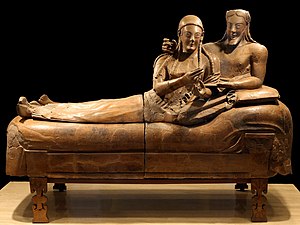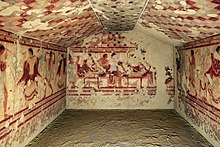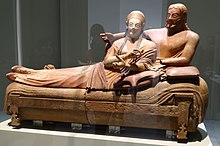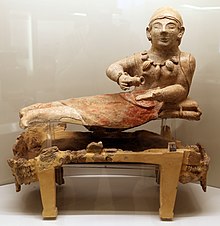Sarcophagus of the Spouses
| Sarcophagus of the Spouses | |
|---|---|
 | |
| Year | 530-510 BCE |
| Type | Terracotta |
| Dimensions | 1.14 m × 1.9 m (3.7 ft × 6.2 ft) |
| Location | National Etruscan Museum, Rome |
The Sarcophagus of the Spouses (Italian: Sarcofago degli Sposi) is considered one of the great masterpieces of Etruscan art.[1] The Etruscans lived in Italy between two main rivers, the Arno and the Tiber, and were in contact with the Ancient Greeks through trade, mainly during the Orientalizing and Archaic Period.[2] The Etruscans were well known for their terracotta sculptures and their funerary art, such as sarcophagi and urns.[2] This sarcophagus is a late sixth-century BCE Etruscan anthropoid sarcophagus that was found at the Banditaccia necropolis in Caere and is now located in the National Etruscan Museum of Villa Giulia, Rome.[1][3]
Description[]
This sarcophagus is made out of terracotta and was once brightly painted.[4] It depicts a man and woman laying on a kline, a dining couch with cushions to help keep the spouses propped up, all of which have been stylized.[4] The man and women's body proportions have been elongated as was common in the Archaic period.[4] Their hair has also been styled in a plaited fashion, though the woman's braids are hanging over her shoulders while wearing a soft cap, and the man has braids behind that are fanned out over his shoulders and back. The faces of the couple show them smiling, and their eyes are distinct almond-shaped, giving them a happier look.[5] Their torsos are made to showcase them comfortably, though there is a line down the middle of the sarcophaguses that shows that they were made as separate pieces. Their legs and hips have been stylized to fit better as a lid, with the only distinguishing figural features showing up at the end of the lid in the shape of their feet.

The man and woman's feet are distinguished from each other, as the man showed

barefoot and the woman wearing pointed-toed shoes, which is an Etruscan characteristic.[5][4] However, the marked contrast between the high-relief busts and the very flattened legs is typically Etruscan along with the interest of the upper half of the figures with their expressive faces and arms.[5] This sarcophagus was created in four separate pieces that were fired separately and then put together later on.[5]
Historical Context[]
Cremation[]
Etruscan culture had an appreciation for taking care of their loved ones' remains; this is seen by how many resources were put into creating their tombs and funerary art, so much so that their cemeteries were often called the ‘cities of the dead’ or necropolis.[3] The main funerary practice for the dead was cremation, where they placed their loved one's ashes and bones into a cinerary urn or ash urn.[3][4][5] The Villanovans, who were people a part of the Etruscans culture, created a different type of urn that was biconical, which are two cones connected together made without a potter's wheel, keeping the clay coarse and unrefined.[5] They also made clay huts to put their remains in, which resemble the houses that they lived in which have been found at an important Etruscan site, Cavalupo.[5] They could also place personal items with them such as weapons for men and jewelry for women.[5] Archeologists have uncovered many different types of Etruscan hut urns that have contained both male and female ashes and bone fragments, so it can be assumed that the Sarcophagus of the Spouses would have originally contained cremated remains.[2][4][5]
Rituals[]
The funerary rituals that the Etruscans created could range from a simple hut and small gathering to those a more elaborate space for loved ones such as a tomb or other funerary art like mosaics and relief sculptures.[4] One such tomb can be found in the Monterozzi necropolis of Tarquinia, Italy, which is known for its painted walls that inform us what they did for their funerals and society.[4] This subterranean rock-cut tomb was used for holding the remains of the dead but also for votive offerings for the ones who have passed.[4] There is a fresco painting on the back wall, which, even though damaged, shows a banquet dinner party, with people being depicted as what is seen of the Sarcophagus of the Spouses.[4] There are three pairs of couples shown enjoying a dinner party, and lounging on klines.[4] In Etruscan banquets, it was a common practice to have both men and woman, who had equal status with the men in their society, share this event with each other as it is represented here in the fresco; the women are by their husband's side and are shown in the same proportions and a similar poses with both parties smiling and expressing affection towards one another.[4][1] The fresco relief, which has the same setting as the Spouses, can show that they have a positive outlook on sending their loved ones to the afterlife since they are sharing their last meals with their family members for all eternity.[4] This is also shown through the Etruscans burying parts of the meal with them along with the proper dishes and utensils so they would have that in the afterlife.[4]

The tomb fresco from Monterozzi also shows how the couples have bright colorful

clothes, which could be compared to the paint that was on the sarcophagus. These bright colors show them as elites.[4] They also have two attendants serving the banqueters, and on the sides of the tomb it is painted to showcase what entertainment the Etruscans would have participated in; for example, musicians are playing and people dancing.[4] Similar to the Greeks they show what gender is being portrayed by what paint they used for their skin, light colors for females, and dark colors for males.[4] From the fresco of Monterozzi, it can be determined that the Sarcophagus of Spouses depicts a normal occurrence. There is also the Banquet Plaque that was found at Poggio Civitate, Murlo, that also has similar iconography of the banquets that the Etruscans held, so another piece that shows these banquets were an important form of ritual for them.[4]
Family Values[]
Another aspect that the Etruscans were known for is their family ties. Since they made such elaborate tombs for their deceased loved ones, and the sarcophagus is based on a couple, it can be seen that family ties were important in their society. The usage of funerary urns and how they were created, such as the spouses, along with the materials, the scale of their urn or sarcophagus, if they add imagery, or how they create the dynamic of their people can also show social ties.[6] There could also be inscriptions, such as family or clan names either located on the outside of the tomb or with their belongings.[6] Another family value that has been touched on earlier in the banquets, which can be seen from the fresco and with the addition with the sarcophagus shows an eternal family dinner.[6]
There are also other types of sarcophaguses that have a family meaning towards them which are the rock-carved funerary beds that have also been found at Banditaccia, where the Spouses were found.[7] These specific sarcophaguses would have identifying features to show who was male and female buried in them.[7] These rock-carved sarcophaguses are in the shape of a bed, and if it was placed on the left side of a tomb it was meant for a male and on the right, it was a female.[7] The male sarcophagus was carved to look like a wooden bed, with the ends laying flat and the legs, if any, were carved in cylinders.[7] Then the females would also have the same features as the male, yet they would be enclosed in a house house-like structure, with the ends of the bed raised in a triangular shape to resemble roofing.[7] There have also been smaller sarcophaguses found near where the women would be buried and have been assumed to be for children.[7] They would also carve out the number and sex of people on the outside of the tomb.[7]
Etruscan Women[]
The women of the Etruscan society have had limited evidence in what they did as a whole but from what has been found from sites dating back to the Orientalizing period, that women of higher society did have the same status as the men.[7] Seen in burials they have had a more lavish and numerous amounts that they were buried with, as well with pottery that would have inscriptions of both their individual name (praenomen) and their family name (nomen), though only free women would have a personal name.[7] It has also been shown that high society women were also literate and that females related to a male by blood ties were respected since they were the ones to continue having children through her bloodline.[7]
Similar Sarcophagi[]

A similar sarcophagus, also from Caere was found at the Banditaccia necropolis. It is also called the Sarcophagus of the Spouses (Sarcophage degli Epoux) and is in the Louvre in Paris (Cp 5194).[3][8] This sarcophagus has similarities that can suggest that they were made in the same studio, from the size, shape, and function of the sarcophagi.[3]
There is a second similar sarcophagus that could have also been from the same studio

and was also found in Caere.[3] The urn of Monte Abatone, which is smaller than the other two, is also made of terracotta and is in a similar style of laying on a couch or kline.[3][9] It differs from the other two in that it is a single figure female, as she poses in a way that depicts her pouring a liquid, possibly oil or perfume, in her hand.[3] This work is also located at National Etruscan Museum of Villa Giulia, Rome, and in 2021 this urn has been going through restoration due to the Museums Restoration Service and the DE.CO.RE Company.[9]

Another similar urn that has the same dynamic as the Sarcophagus of the Spouses, just a smaller version. This urn also has a couple, the bare chested man embracing the clothed women, leaning up against pillows, laying on a kline with their legs covered up and feet slightly sticking out.[6] The man also doesn't have a beard, making him younger looking.[6]
References[]
- ^ a b c "ETRU Museo Nazionale etrusco di Villa Giulia". www.museoetru.it (in Italian). Retrieved 2021-10-27.
- ^ a b c Hemingway, Colette (October 2004). "Etruscan Art". www.metmuseum.org. Retrieved 2021-11-08.
{{cite web}}: CS1 maint: url-status (link) - ^ a b c d e f g h de Grummond, Nancy Thompson; Pieraccini, Lisa, eds. (2016-12-31). Caere. University of Texas Press. pp. 97–184. doi:10.7560/308431. ISBN 978-1-4773-1045-8.
- ^ a b c d e f g h i j k l m n o p q r "Guide to Ancient Etruscan Art". Open Textbook Library. 2019. Retrieved 2021-11-09.
- ^ a b c d e f g h i Kleiner, Fred S. (2010). A History of Roman Art, Enhanced Edition, p. xxvii-xlvii. Wadsworth, Cenage Learning.
- ^ a b c d e M., Curry, Virginia (2012). Familia in Eternam : the intimate imagery of the egalitarian Etruscan couple. Southern Methodist University. ISBN 978-1-267-90758-5. OCLC 861556780.
- ^ a b c d e f g h i j Haynes, Sybille (2000). Etruscan Civilization: A Cultural History. Los Angeles, California: Getty Publications. pp. Whole Book. ISBN 978-0-89236-600-2.
- ^ urne, 0510, retrieved 2021-10-27
- ^ a b "ETRU National Etruscan Museum". www.museoetru.it. Retrieved 2021-10-27.
- 6th-century BC works
- Collections of the Villa Giulia
- Etruscan ceramics
- Etruscan sculptures
- Sarcophagi
- Terracotta sculptures in Italy
